The EVGA 7300 GS: A New Quality Budget Card From NVIDIA
by Josh Venning on February 20, 2006 12:23 PM EST- Posted in
- GPUs
Performance Continued (Medium Quality)
Because the performance that we saw on these games at high quality settings were so low, we ran a second set of benchmarks with the graphic settings at medium for each of these games at the same resolutions. This should give us a better idea of performance, as these games can still be enjoyable with certain effects like full dynamic range (in HL2LC) disabled. For Battlefield 2 and Quake 4, we simply used the overall medium graphics setting that these games both provide, and with Halflife 2 Lost Coast, we simply turned model and texture detail to medium, and set the shadow detail to low. We also set the HDR effects to "bloom" only and water reflections to "simple".
Battlefield 2 Performance (medium quality)
Because the performance that we saw on these games at high quality settings were so low, we ran a second set of benchmarks with the graphic settings at medium for each of these games at the same resolutions. This should give us a better idea of performance, as these games can still be enjoyable with certain effects like full dynamic range (in HL2LC) disabled. For Battlefield 2 and Quake 4, we simply used the overall medium graphics setting that these games both provide, and with Halflife 2 Lost Coast, we simply turned model and texture detail to medium, and set the shadow detail to low. We also set the HDR effects to "bloom" only and water reflections to "simple".
Battlefield 2 Performance (medium quality)
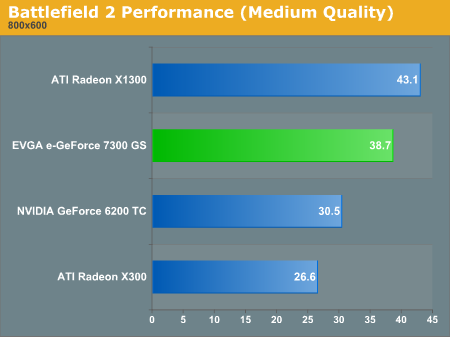
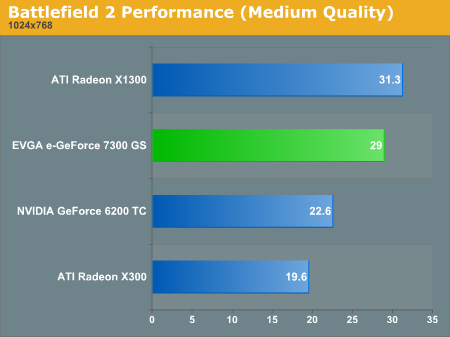


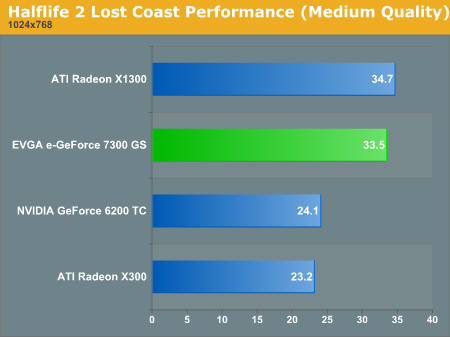
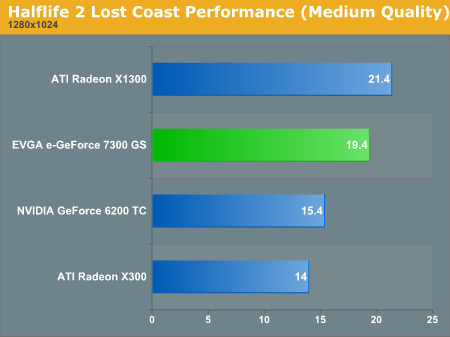
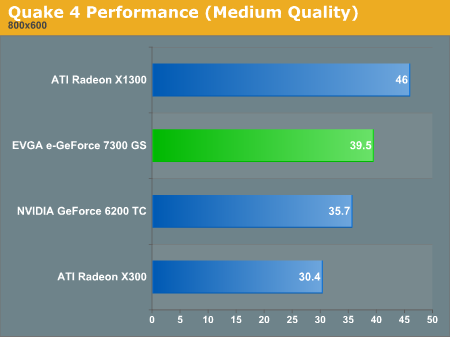
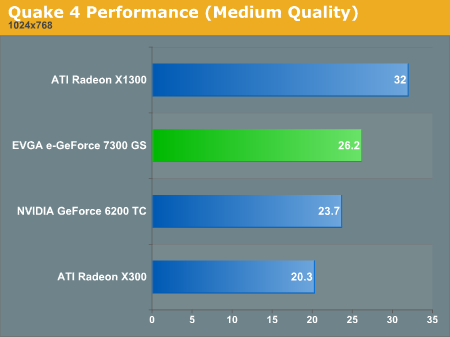
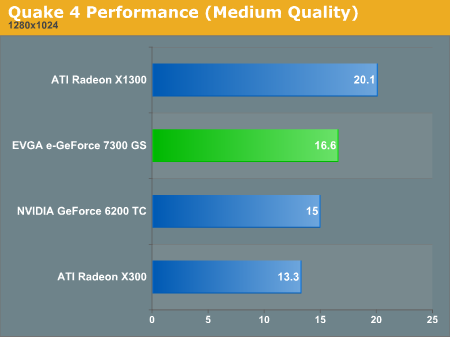










48 Comments
View All Comments
yacoub - Tuesday, February 21, 2006 - link
To paraphrase your post, "This isn't a CPU scaling analysis to provide useful data to you to see how this GPU would perform for an actual system that would use it."That's exactly what I'm saying too.
Egglick - Tuesday, February 21, 2006 - link
It seems that after every low/midrange videocard test, there's always a couple "simple" people crying about how the CPU used for testing was too fast.The point is to test the videocard, and the videocard alone. Adding other variables such as slow CPUs and memory bottlenecks only complicates things, and gives you a skewed view of how the videocard actually performs when there aren't other components affecting it's performance. This is a videocard test, not a full system test. Adding slower components to drag down the scores would give us incorrect results as to how the videocard performs. Obviously you haven't taken any science classes beyond basic highschool level.
What you're asking for is a CPU scaling test (where it's known that the videocard isn't the only variable), and they much more involving and time consuming.
yacoub - Tuesday, February 21, 2006 - link
My system is pretty highend yet I'm at least capable of understanding the pointlessness of this review for the folks who would actually buy this card, while you are clearly not able to do so.
Wow, how worthless is that for the buyers of this card.
Again, worthless. adding a realistic CPU for the system this card would be in would give you an ACCURATE view of how the card ACTUALLY performs.
I don't know about you, but I don't play games on a videocard, I play them on a complete computer, thus knowing how the card performs in a real world system of someone who would actually be interested in this card would make the MOST sense.
Obviously you can't comprehend simple logic and reasoning and resort to personal attacks, but at least some folks here are a bit more capable.
No, what we're asking for is a useful test of this videocard in the type of system it'd actually go in. It's no more "time consuming or involving" than this test, really. Just put in a different CPU and you'd be 90% of the way there.
Show me a gamer who buys an $800 CPU but a budget GPU and I'll show you the person who hasn't "taken any science classes beyond basic highschool level".
peldor - Tuesday, February 21, 2006 - link
A Sempron is easily capable of delivering faster framerates than these video cards, let alone a low-end Athlon 3000+. Maybe on a Celeron you're dropping low enough that the CPU is a bottleneck.On a mid-range card review, your point would be much more relevant. For these cards, not so much IMO.
yacoub - Tuesday, February 21, 2006 - link
They should mention that then, at least in the conclusion if not in the Test Setup page.oneils - Tuesday, February 21, 2006 - link
No, we're just asking Anandtech to back up their conclusion:"While many gamers will find the card unappealing because of its limitations, it does have the ability to play games at lower quality settings and resolutions quite well, and for those who only dabble in gaming and don't feel like spending much money on an upgrade, this card might be a good choice."
Really? A good choice? For who? FX-55 users? Or are mid-range cpu users included in this as well?
yacoub - Tuesday, February 21, 2006 - link
And if mid-range cpu users are included in their statment as well, how can they justify such a comment when they didn't actually test the card in a mid-range box - the very type of system this card would be put in?Don't expect a reply though, you're making too much sense. ;P
mczak - Monday, February 20, 2006 - link
Sorry, but the performance numbers are completely useless if you don't mention if the cards in question have 32bit/64bit/128bit memory interfaces, the amount and clock speed of the memory (especially important for the TC cards). Those cards can easily differ by a factor of 2 if compared to themselves (i.e. card with the same name) just because of that alone.Questar - Monday, February 20, 2006 - link
"The 7300 GS will most likely raise the bar for budget cards in the future."How can it raise the bar when it performs worse than, and costs more than an x1300?
tedward - Monday, February 20, 2006 - link
Nvidia is claiming that this card will offer great video/DVD playback. I would think most people interested in this card would be non-gamers, with a HTPC box. Would be nice to see how it performs compared to the x1300 w/Avivo, and the 6150/430 chipset.